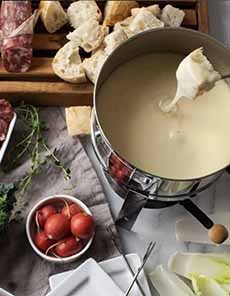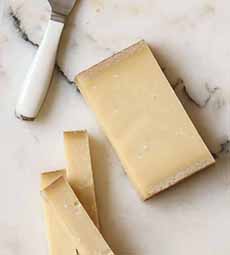Fondue Vs. Fonduta: What Is The Difference?
|
April 11th is National Cheese Fondue Day. Fondue, a melted cheese dish (photo #1), originated in the Swiss canton of Neuchâtel. (Don’t confuse Neuchâtel with Neufchâtel, a soft cheese made in Neufchâtel-en-Bray, a commune* in the French region of Normandy.) Fondue, which derives from the French verb “fondre”, meaning to melt, is an 18th-century dish that enabled farm families to stretch their limited resources during the winter months. With some bits of cheese, some stale bread for dipping, and a dash of wine, the family had dinner [source]. The dish found its way from the farms to towns and cities: There are 26 cantons in Switzerland, each with its own variation of the recipe. Modern fondue is generally made from at least two varieties of cheese, plus alcohol and a bit of flour or cornstarch to keep the melted cheese from separating. Garlic and other seasonings can be added. What makes one recipe different from the next? The particular blend of cheeses, the alcohol (wines, liqueurs, spirits) and the seasonings. Traditionalists will tell you that one of the cheeses has to be Swiss Gruyère (photo #2). Switzerland designated fondue a national dish† in the 1930s. The World Fondue Championships (Mondial Fondue) was established in 2015, and is held every other year. In 2019, more than 120 competitors combined different cheeses and wines, hoping to carry off the honors in professional and amateur categories. (In the Championships, the cheese component must be at least 50% Swiss Gruyère.) Fondue crossed the pond some time after World War II with numerous other European dishes. It became extremely popular in the U.S. during the 1960s. American stores did quite a business in fondue pots. Here’s more about fondue. Fonduta is the Italian version of fondue—i.e., melted cheese—but it’s not the same. Instead of Gruyère, fonduta is made with Fontina (photo #3), a young cows’ milk cheese that melts easily and tastes similar to Gruyère. Fontina cheese—and hence fonduta—is a specialty of Piedmont and Valle d’Aosta, both at the north of Italy, just over the border from Switzerland. The big difference between Swiss fondue and Italian fonduta is that the Italian recipe does not include alcohol, garlic, or a cornstarch/flour thickener. Instead, the Fontina is blended with butter and milk, and egg yolks are used as the thickener, making it more custardy. The classic Italian finishing touch is a shaving of white truffle—or for most of us, a drizzle of truffle oil instead. Similar to fondue, fonduta is served with crostini (toasted bread slices, as opposed to untoasted bread with Swiss fondue); boiled fingerling potatoes and cornichons (photo #4). ________________ *French communes are analogous to civil townships and incorporated municipalities in the United States and Canada. †Rosti, thinly grated potatoes that are pan-fried until crisp and golden, is another of Switzerland’s national dishes. It’s another dish with farm origins: Farmers in the canton of Bern would traditionally eat it for breakfast [source]. |
|
|
|
|
||



